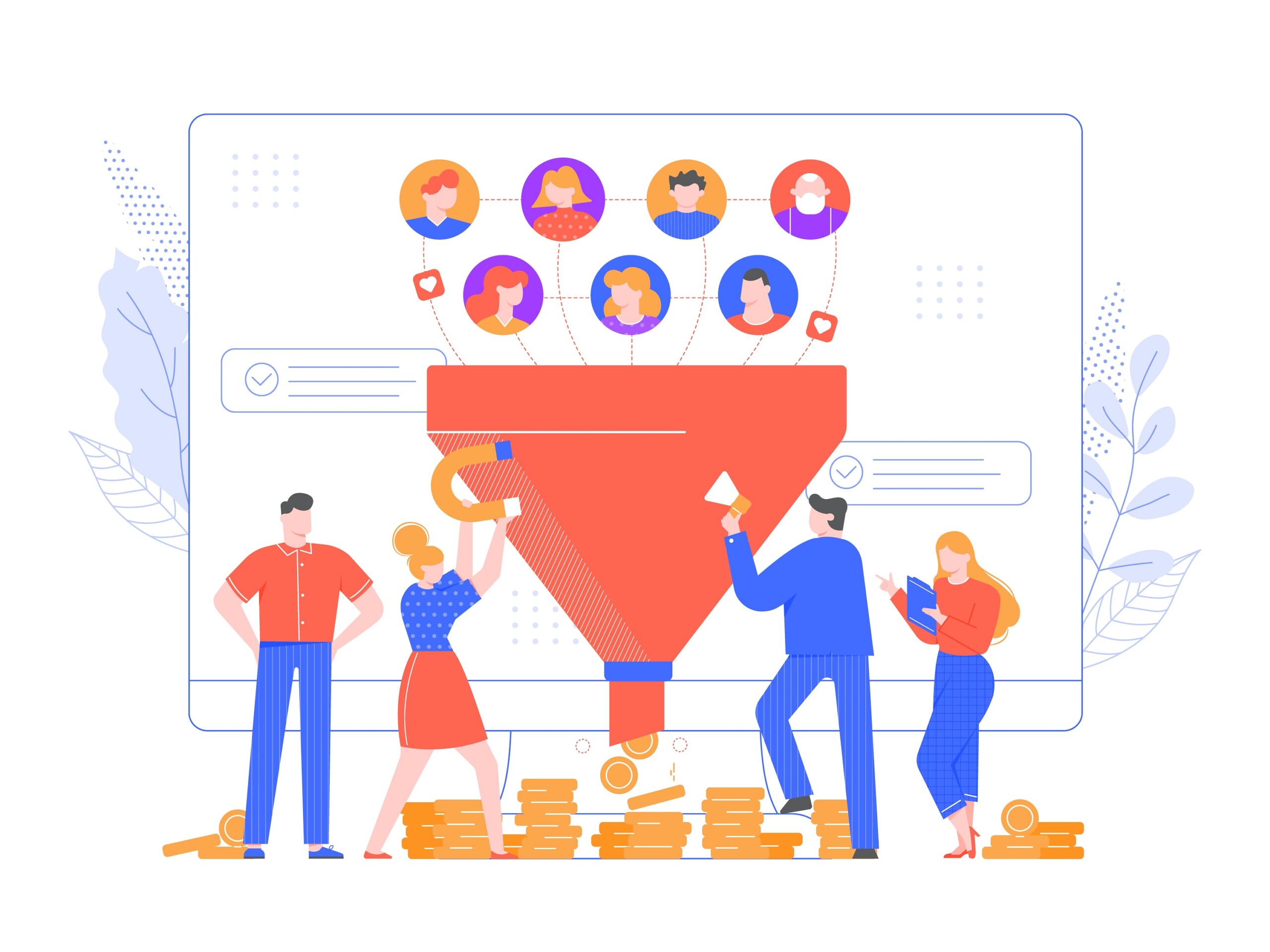What is B2B Lead Generation
B2B lead generation is the process of seeking out and converting qualified prospects into leads.
It involves lead generation, lead qualification, and conversion. Leads are qualified based on whether they need your product or service, their budget size, the role of decision-maker in the company (if any), and many other factors.
Marketing-Qualified Lead VS Sales-Qualified Lead: What’s the Difference
These two terms can be confusing, so it’d be best if we define what’s MQL and SQL first.
What is a marketing-qualified lead?
Marketing-qualified leads are prospects who have shown interest in a company’s product or service, but may not be ready to buy. They need more information before they commit and represent the top of your sales funnel.
MQLs typically come from things like advertising campaigns (paid ads on Facebook, Google), blog posts, social media content marketing efforts such as LinkedIn Influencer Marketing RSVP Gatherings, and targeted email campaigns.
An example of an MQL might be someone who has downloaded an eBook about CRMs for sales reps and is curious about how the software works with Salesforce.
What is a sales-qualified lead?
Sales-qualified leads are much further along in the sales process. They’ve shown interest in a company’s product or service, and are ready for professional help to make their decision easier.
SQLs typically are those leads that have been contacted by a sales rep, have requested more information about the company’s offerings, and are ready to buy.
An example of an SQL might be someone who has accepted a demo with your team, shown interest in purchasing software for their business and is very close to making that purchase decision.
Best Way to Generate B2B Leads
There’s no secret technique in generating B2B leads. Even experts can’t decide on which B2B lead generation tactics and channels are the best.
Hubspot has created a chart to tell you where your leads come from.
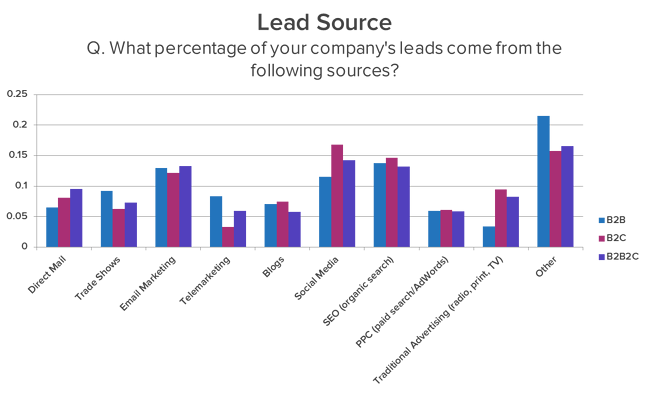
(Image Source: Hubspot)
You’d see all the typical B2B lead generation strategies and channels — email marketing, trade shows, direct mail, etc.
However, you may notice on the chart that the biggest source of B2B leads is labeled as “Other.” Well, it looks like the experts can’t really figure it out.
According to Jaakko of LeadFeeder: “The best way to generate more sales is to tailor your B2B strategy around your industry, product, and buyer.”
How to Set up a B2B Lead Generation Process in 4 Steps
Setting up your business to business lead generation process doesn’t have to be difficult. Here are the four steps you need for a successful and effective process:
Step 1: Build lead list
Building a lead list is important because it provides you with a list of potential customers for your business. And without customers, your brand will cease to exist!
But what if you don’t have the time or resources to build one? LeadFuze can help!
With its easy-to-use platform, you’ll be able to find and drive qualified leads in minutes. You’ll also get access to its lead management system that lets you track your progress and stay on top of your campaign’s performance.
Don’t waste any more time trying to figure out how to create a list of potential customers – let LeadFuze do it for you! It will work with you every step of the way so that it can deliver high-quality prospects right into your inbox. And best yet, they’re ready for sales calls when they arrive at your desk!
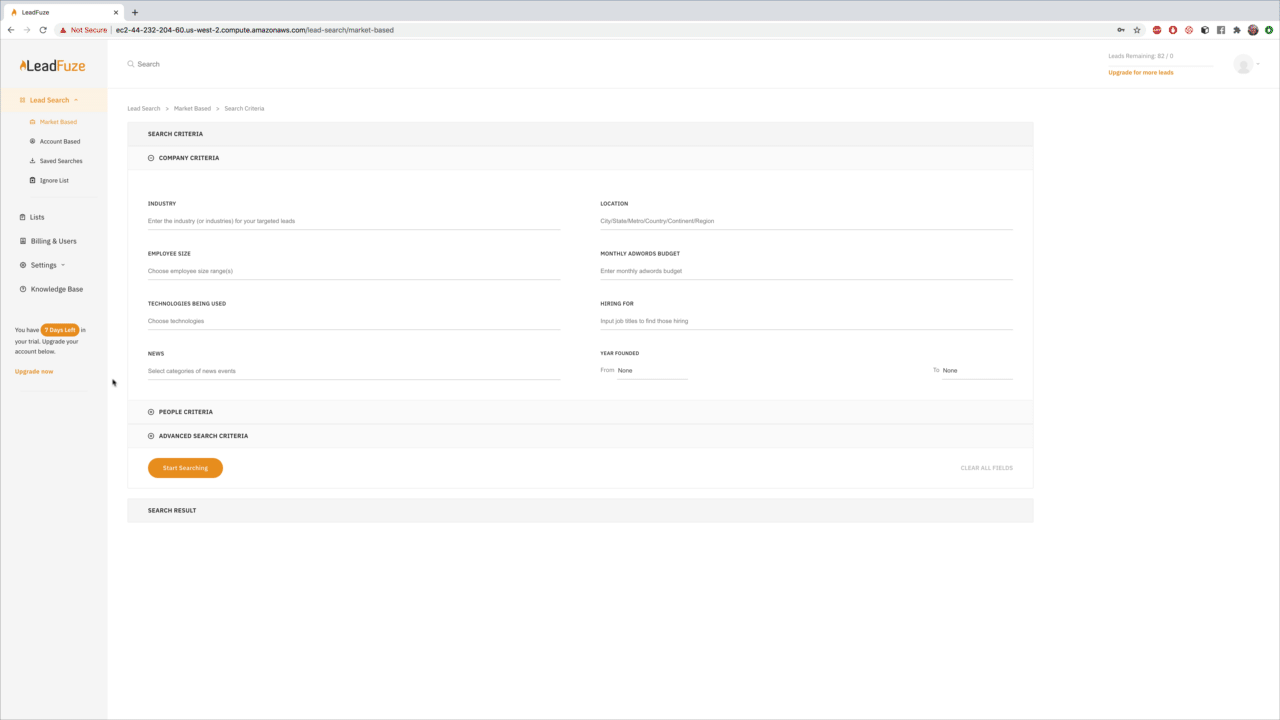
Step 2: Create a cold email template
After getting a list of accurate leads, it’s time to create a cold email template. A cold email is a customized message that you’ll send out to your prospects. It will help them remember who you are and what they could be missing by not working with your company!
Cold emails can make or break your campaign, so it’s important to create one that stands above the rest.
Step 3: Launch your cold campaign
Launch your cold campaign by sending out your cold email to all the people on your list. This is a great opportunity for you to get feedback from prospects and see if any of them are interested in working with you.
Step 4: Monitor the performance and optimize
Monitor your cold campaign, so you can see if any changes need to be made. You may have sent out too many emails, or not enough – either way, it’s important to make sure your campaign is as successful as possible!
Don’t forget to optimize your cold email template, so you can get an edge over the competition and increase conversions from prospects.
This will ensure that your cold emails are personalized and have the best possible chance of getting opened.
28 B2B Lead Generation Ideas and Best Practices
Here are some B2B lead generation ideas you can apply to your next B2B journey:
1. Use LeadFuze to find contact details
We all know that generating quality B2B leads is a challenge. It’s hard to find the right people to talk to, and it takes a lot of time.
LeadFuze makes finding contact details for your target audiences easy! Simply type in your search criteria, click Search, and it’ll show you who you should be talking to.
Using its database of over 70 million contacts around the world, it can provide verified email addresses, so you can start building relationships with decision-makers at companies like yours within minutes!
Its state-of-the-art technology finds the most relevant business leaders for any search term or location in seconds – saving you hours of research time every week.
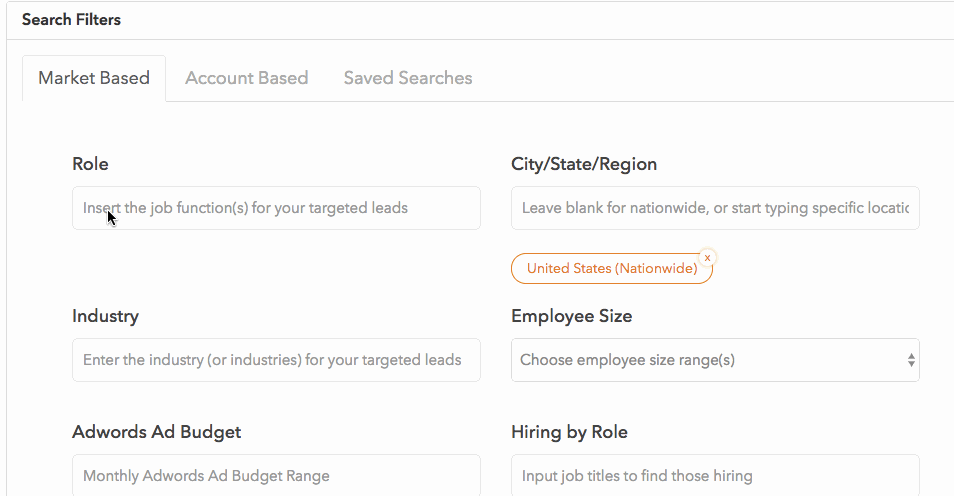
2. Automate B2B lead generation and email marketing campaign
Automation can help B2B companies achieve great results. With an automated campaign, you can set up lead generation B2B forms on your website to capture a prospect’s information, which will automatically be sent as an email.
You won’t need to spend hours sending out emails or filling in the company data manually – it’ll all happen automatically!
3. Build a free tool to attract leads
You can use a free tool to attract leads. A service that your customers are already using, such as Salesforce or Zendesk, is an excellent option – it’s the customer’s best experience, and you’re not giving away anything proprietary.
You could also provide something like a calculator for estimating how much electricity a business will use, or a tool to help create an accurate budget.
These free lead generation tools can be used as marketing assets that will generate leads for you and your company.
4. Give incentives
Offer something of value to your prospects – a free report, an online assessment, or any other information that is valuable to your target market.
When they visit your website and give their contact details for the offer you’re giving them in return, it will automatically fill up all the lead’s personal information on your CRM – sparing you from spending hours trying to do this manually.
5. Create referral campaigns to get more leads
A referral campaign can be a great way to get more leads. Offer your customers discounts or incentives for referring their friends and family members to you, which will create an attractive offer that people can’t refuse.
If they refer someone who becomes one of your clients, they’ll receive the discount as well! This is also known as word-of-mouth marketing – where the customer of your company goes and talks about you to their friends.
6. Set up re-arrangement and customer retention programs
Bringing dead leads back to life with re-engagement services is a smart move. You’ll save on advertising costs, and it’s always nice to do something for your customers that they enjoy!
You can use this in conjunction with the referral program mentioned above – if someone refers their friends but doesn’t get a discount themselves, you could offer them an incentive to get them to refer to their friends.
7. Create an automated webinar strategy
91% of B2B professionals prefer webinars over any other form of business or marketing educational content.
The webinar strategy starts with a blog post about your company and the products you offer, followed by an invitation to view a recorded version of the live event on your website afterward. The goal is to have them then sign up for future events so that they can watch recordings at their convenience!
8. Turn blog posts into in-depth guides
Create a blog post and turn it into an in-depth guide, with downloadable templates. It’s also important to make sure your content is written for someone who has never done this before so that they can learn all the basics.
What you don’t want is for them to find out what they need when they already have everything set up because then they’ll have to go back and change it all.
9. Add dynamic CTAs to blog posts
Add dynamic CTAs (call to action) to your blog post. CTAs are important because they tell people what to do next, and this is the last thing you want them thinking about when they finish reading a blog post that didn’t have an actionable CTA.
10. Obtain email leads from video views
Oftentimes, people will watch a video about your topic, and then they’ll go to the blog post for more information.
You can ask them for their email to receive updates on that particular subject by adding something like this: “If you’re interested, please enter your email below.”
11. Segment your content strategy
Segment your content strategy to create more qualified leads. You need to know your audience and be able to create content that is going to resonate with them.
There are two ways to segment your strategy: by persona or by industry.
If you’re a blogger who focuses on specific topics, this is the best option for you because it will help create more targeted content. If not, try researching what type of industries your prospects and customers belong to find out which content type to produce.
12. Create a content calendar
Creating a content strategy and creating an editorial calendar is essential for B2B sales lead generation success, as it keeps you more organized and helps with prioritizing what needs to be done first.
It also enables you to have better control over your content distribution because if there is no time to publish new content, you can use your existing material instead.
13. Pack content with shareable ideas and data
The goal of B2B content is to educate, inform and persuade. Make sure you are including the most valuable data in your blog post or white paper so that readers can spread it on social media for you.
The more people share your content, the higher chances there will be for someone who needs what you offer to see it.
14. Update old content
If you don’t update your content regularly, someone else will. That means that they could publish the same ideas as yours and win more followers because of it.
15. Make a list of negative keywords in Google Ads
Negative keywords are words or phrases that you want to avoid targeting in your Google Ads.
For example, if you have a blog post about dogs and cats but would like to target people who are interested in hiking as opposed to pet owners, then “dog breeds” and “cat breeds” should be on your list of negative keywords.
16. Run A/B test on your key pages
When you’ve completed a new piece of content, run an A/B test to see which headline or image is more appealing. This way, you can see which one performs better and makes the most money for your business.
17. Cater to new buyers on mobile
Mobile is the future of B2B marketing and leads, so you’ll want to cater your content for this platform.
If you are targeting a mobile audience, make sure that it’s clear throughout your site what information each page contains. You should also include links in a text format instead of hyperlinks if possible since it’s easier to click on a link with your finger than it is with a mouse.
Your landing page should also be mobile-responsive and optimized for search engines so that if you rank high in the SERPs, more people will find your company and contact them.
18. Optimize long-tail keywords to get qualified leads
Long-tail keywords are specific keywords that have much lower competition and usually result in more qualified leads than short-tail.
One of the best ways to use long-tails is through SEO: optimizing your site for these key phrases will help people find you online, which can lead to conversion if it’ll work well with your company’s business model.
For example, the term “types of network infrastructure” is more specific than a generic search like “technology.” This kind of phrase will likely bring in less traffic but people who are looking for this particular information would be much more qualified than someone searching for technology without any idea what they’re looking for.
19. Run campaigns based on competitor keywords
If there are competitors in the B2B space, identify which keywords they’re bidding on, so you can target them as well. This will allow you to take a look at what other companies are trying and determine whether it would work for your company too.
Keep in mind that when targeting competitor keyword phrases, you want to bid on the same phrases they are using but with a higher max CPC.
20. Improve messaging with stronger microcopy
When you’re writing copy for a specific campaign, it’s important to use strong messaging. This means that when someone lands on your landing page, they should know what the offer is without scrolling or clicking around.
We recommend using a stronger microcopy (i.e., “Get this now!” vs. “Interested?”) to get your message across.
21. Observe how B2B buyers browse your site
Browsing behavior is different for B2B and B2C customers, so it’s important to make sure your site works well and is easy to use with the most popular browsers. Consider using platforms like Tidio (or Tidio alternatives) to convert your website visitors into paying customers with live chat
For instance, according to Statista (2018), Google Chrome has a 52% market share in global usage among desktop users.
22. Tweak your landing page
Tweaking your landing page by adding a few more CTAs is an easy and relatively inexpensive way to improve conversions.
For instance, the team at Hubspot found that simply adding personalized CTAs on their landing page increase conversion rates by 202%.
23. Score leads to increase sales
To increase sales, you can score leads based on their buyer persona and company size.
For instance, if your lead is a business development professional at an enterprise-level organization that has over $100 million in revenue per year then they are worth more than the average BDR with a mid-sized company for less than $100 million in revenue per year.
24. Earn trust with social proof
Adding a video testimonial from an employer on LinkedIn can be more powerful than just listing the company logo design or employee name in text.
Having this type of content on your landing page will help to increase conversions and make it appear that you are a reputable organization. It is important to have trust with prospects because they will be less likely to buy from you if they are not confident in your company.
25. Personalize website with dynamic web pages
Make your website personal to the visitor with dynamic web pages. Dynamic web pages are a great way to stay updated and give prospects more information for their needs, which will increase conversions because they feel as if you care about them and have what they need.
26. Do guest posts
Guest posts are a great way to get more visibility for your brand and yourself. Not only will you be getting seen by new prospects, but also the writer of that blog post may link back to your company website or vice versa if they have something on their site related to yours.
27. Upsell popular content
Upselling is a great way to increase your profit margins and make more money. Offer popular content at the top of your landing page or on individual blog posts for new leads who are not sure about what they want from your company yet.
This will allow them to buy something that’s already proven successful, which increases conversions because the customer knows they are getting a quality product.
28. Co-host a webinar
Co-host a webinar with a company you want to partner with. This ensures that your message is being seen by their prospects and vice versa, which increases the likelihood of generating sales leads for each organization.
Pairing up also saves time since both organizations do not have to create individual webinars about the same topic or worry about duplicate content on social media sites.
7 B2B Lead Generation Software
There are many B2B lead generation software options available. Here are some you can choose from:
1. LeadFuze
LeadFuze is a great B2B lead generation software that can help you generate new leads.
You can use it to do the following:
- Generate leads from events on the web
- Create a campaign to capture leads and automate your marketing tasks.
- Get leads for any company size, regardless of budget or technical skills required
It does not require any installation of hardware or software, making it a highly scalable solution that can grow with your business needs. It doesn’t matter if you are just starting now or want something more advanced.
Furthermore, it’s an affordable, easy-to-use, and scalable solution that can grow with your business needs. With access to the LeadFuze dashboard, you have all the information you need readily available.
Sign up to get 25 leads for FREE!
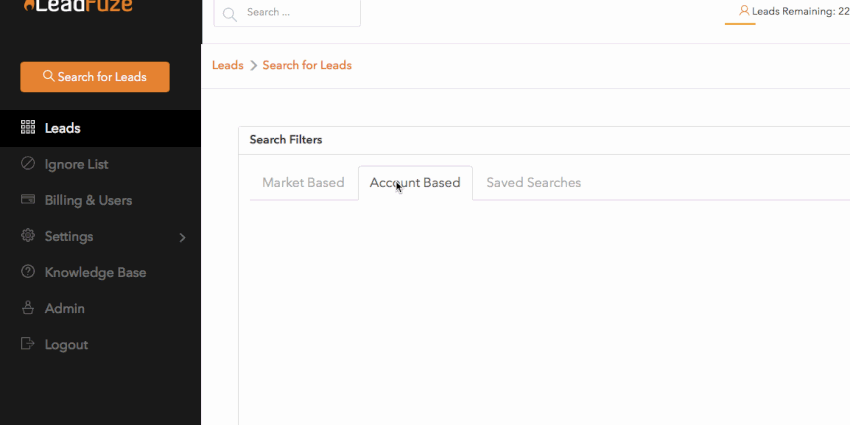
2. Optimonk
This is one of the cloud-based lead generation tools that’s been around since 2005. It offers the best in BizTech and Marketing Technology, so it can help you get your lead generation campaigns up to speed with other channels.
It can be used to do the following:
- Routine marketing tasks and automation
- Contact database management
- Lead qualification
- Marketing campaigns, both automated and manual
Optimonk offers a 14-day free trial and does not charge for set up, but it charges $199 per month if you stay on past the initial two weeks. It also has an enterprise plan that starts at $499/month with no setup fees.
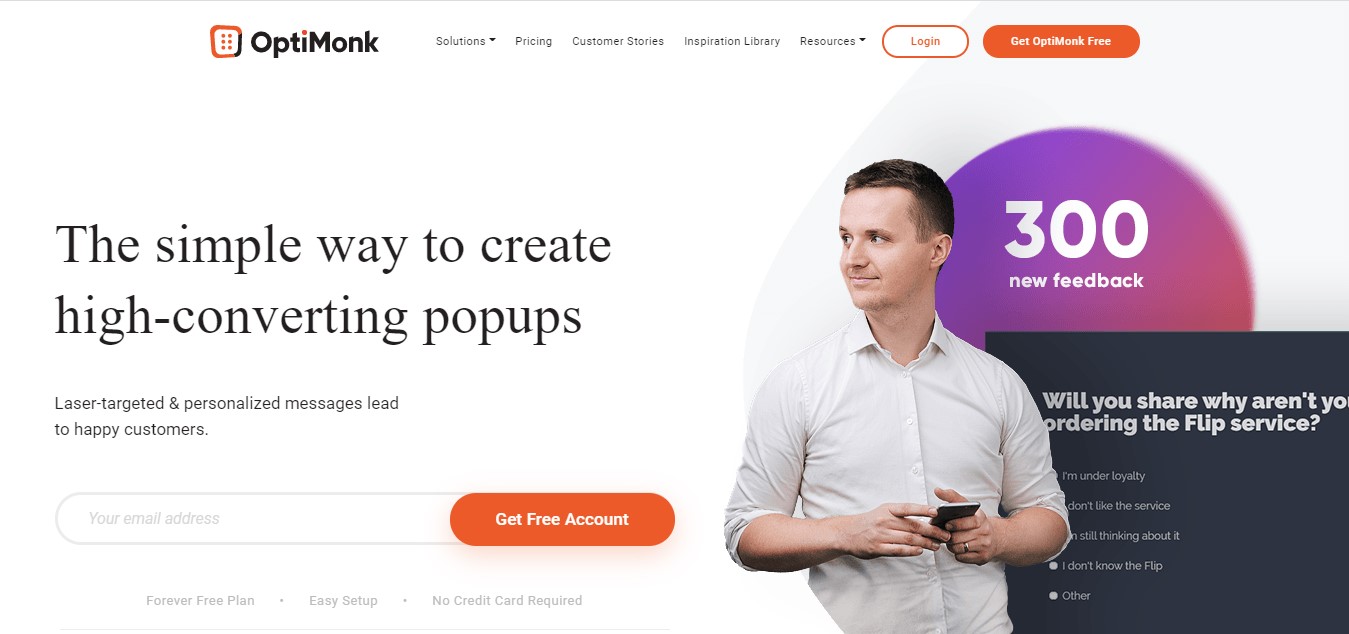
3. Unbounce
Unbounce is an all-in-one sales lead generator that can be used to create high-quality landing pages. It offers a toolkit with templates, design software, and conversion tools to help you improve your marketing efforts.
It can be used to do the following:
- Create landing pages for email marketing, content marketing, and social media
- Test different designs to find the most effective one
- Track conversion rates of specific campaigns easily with analytics tools
Unbounce offers a free trial period so that you can try it before making any commitment. The Enterprise plan starts at $499/month with no setup fees.
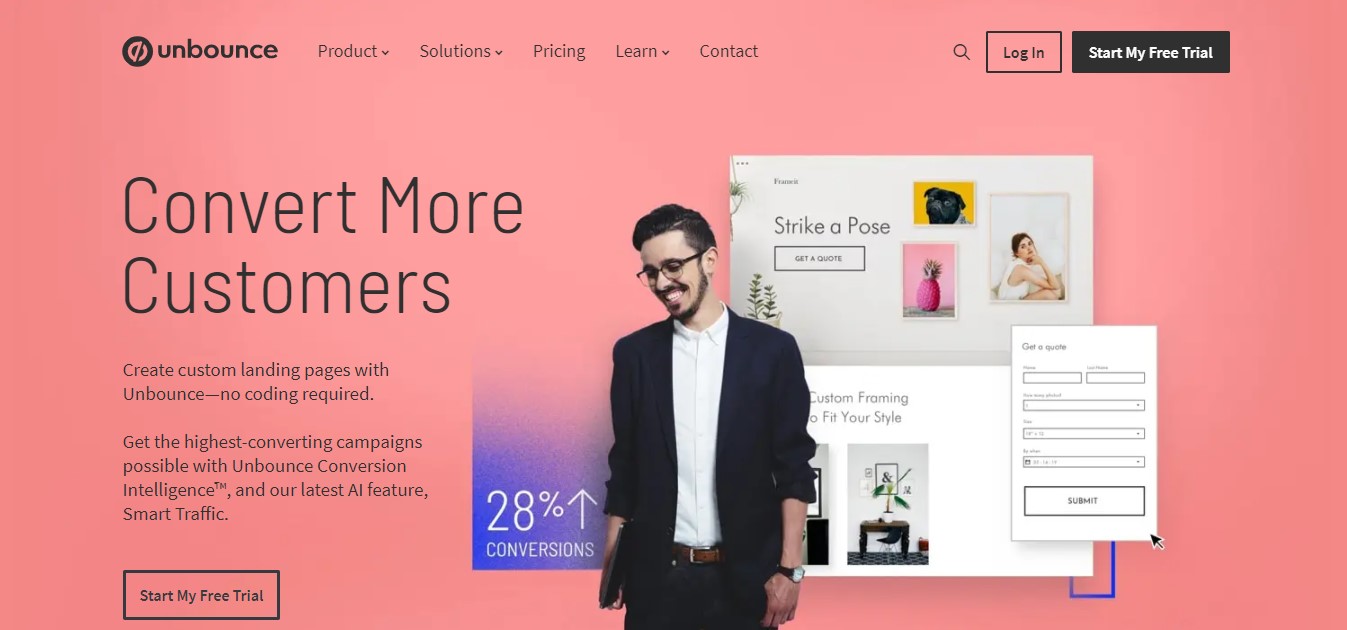
4. LeadFeeder
LeadFeeder is a lead finder tool that can be used to manage and monitor lead generation campaigns.
It can be used to do the following:
- Monitor any email address or domain that you are using for lead generation campaigns
- Follow up with leads and send them personalized messages based on their interests, such as new blog posts about your company or products.
- Set up automated responses like a white label autoresponder.
- Easily identify the most effective email templates and calls to action that work best for your marketing campaigns
- Track conversions rates with analytics tools
LeadFeeder offers a free trial period so you can try it before making any commitment. The Enterprise plan starts at $49/month per user, which includes unlimited emails and a team of up to five users.
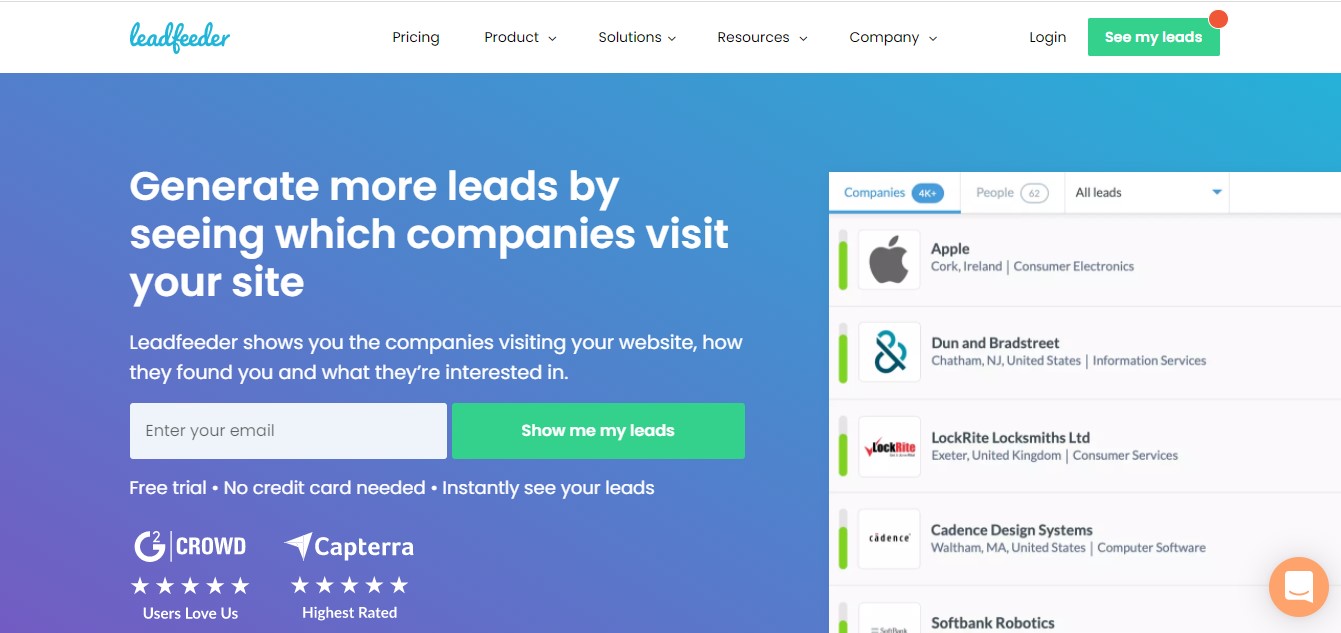
5. Albacross
Albacross is a free lead generation software that helps B2Bmarketers generate high-quality leads using artificial intelligence. The company’s proprietary algorithm is designed to analyze the content of your website and automatically identify people who require what you have to offer, then it starts a conversation with them.
You can also identify specific audiences for lead generation campaigns by leveraging Albacross’s AI.
You can use it to do the following:
- Identify potential leads
- Set up a personalized conversation with high-quality prospects
- Get in touch with decision-makers at the company you want to do business with and make it easier for them to take your call or answer your email
- Build an effective lead generation campaign using AI algorithms. Albacross’ artificial intelligence identifies people who need what you offer, then starts a conversation
- Identify your target audience and identify the best marketing channels for them
Albacross costs $0.003 per interaction or lead and has a free trial for those who want to test it out first.
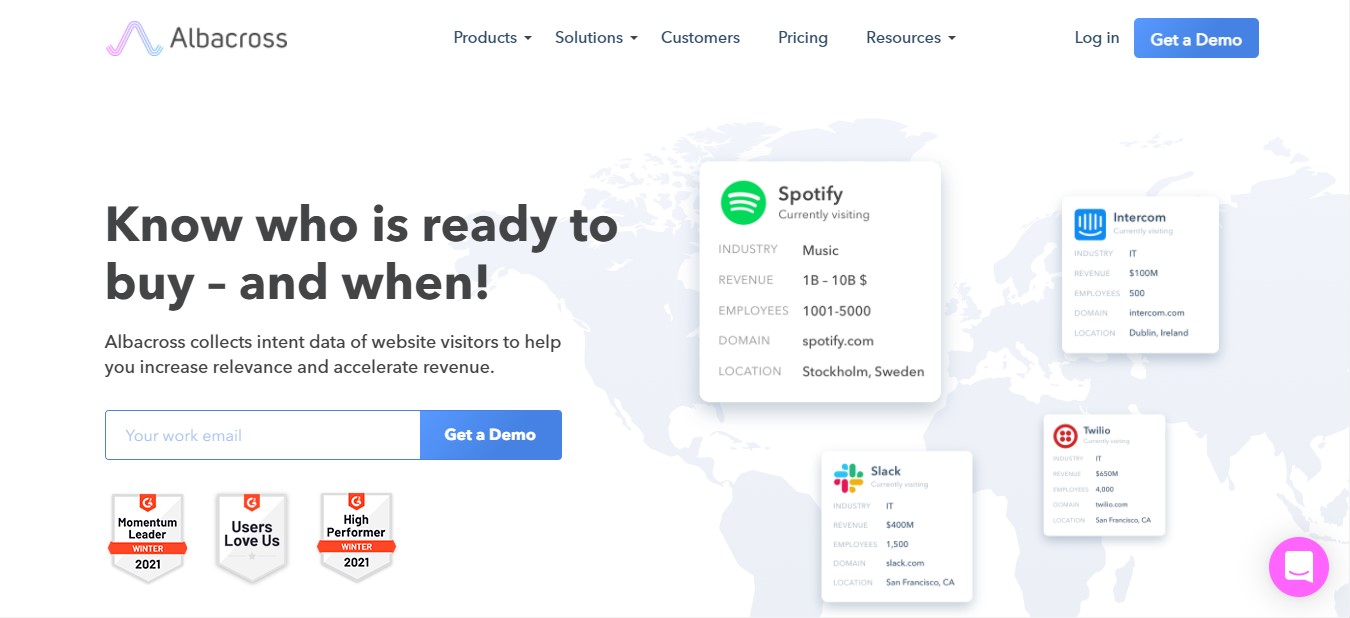
6. LeadQuizzes
LeadQuizzes is a software-as-a-service solution for business professionals and marketing agencies. The company offers a suite of tools ranging from lead qualification to email nurturing.
You can use it to do the following:
- Qualify leads and cuts down on time wasted chasing unqualified prospects
- Segment your leads according to needs, interests, or location
- Automatically generate personalized emails that are relevant to the recipient or serve as lead magnet
Its email editor is made up of a series of modules designed with marketers in mind, enabling you to create personalized, relevant, and mobile-ready emails in just a few clicks.
LeadQuizzes costs $25 per lead or $450 for a 100-lead pack.
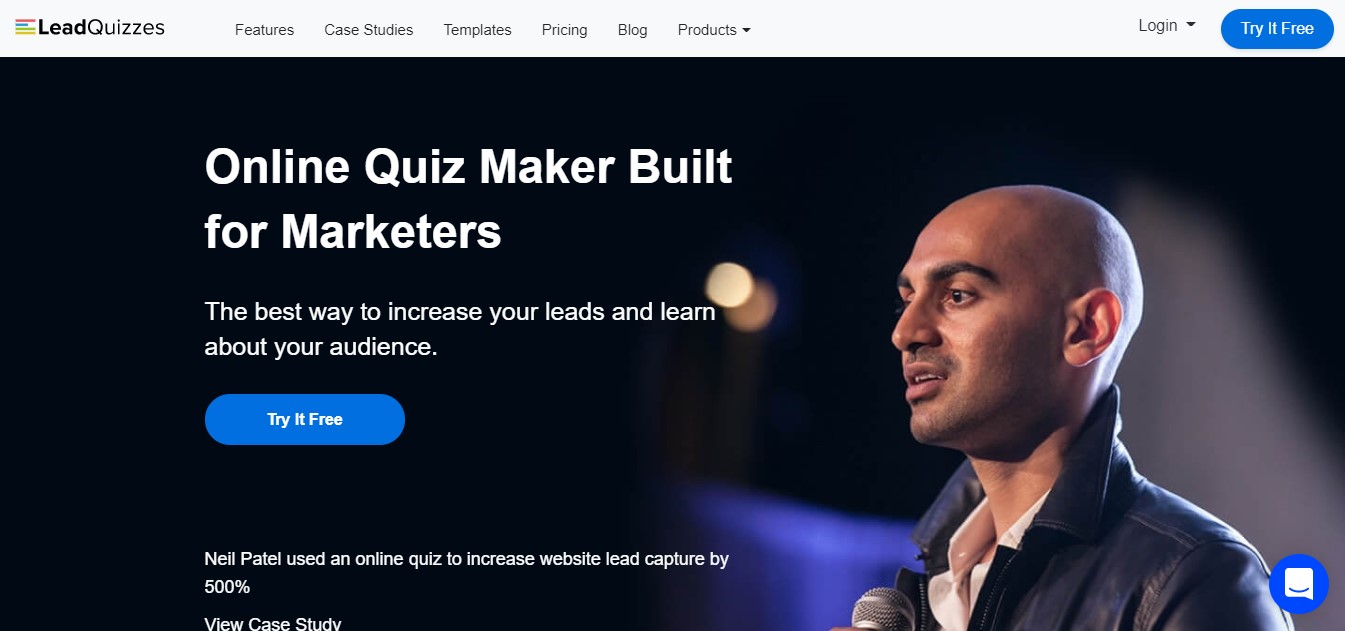
7. Vyper
Vyper is an Australian-based marketing automation service that helps businesses create and send personalized messages to their leads.
It’s packed with features, including lead scoring tools (which help you prioritize your list), automated email campaigns, and an inbound routing system that deals with a voicemail or live chat automatically
You can use it to do the following:
- Send personalized emails to specific recipients based on their preferences and interests.
- Set up automated campaigns that send out messages according to a set schedule, in which you can add any number of optional attachments like PDFs or links to online resources for your leads.
- Create different message templates with Vyper’s personalization tools, so you’re always sending the message your leads want to receive.
It’s available on both desktop and mobile, so you can use it from anywhere at any time.
Vyper costs $49.99 per month to start, but you can try it for free with a seven-day trial period!
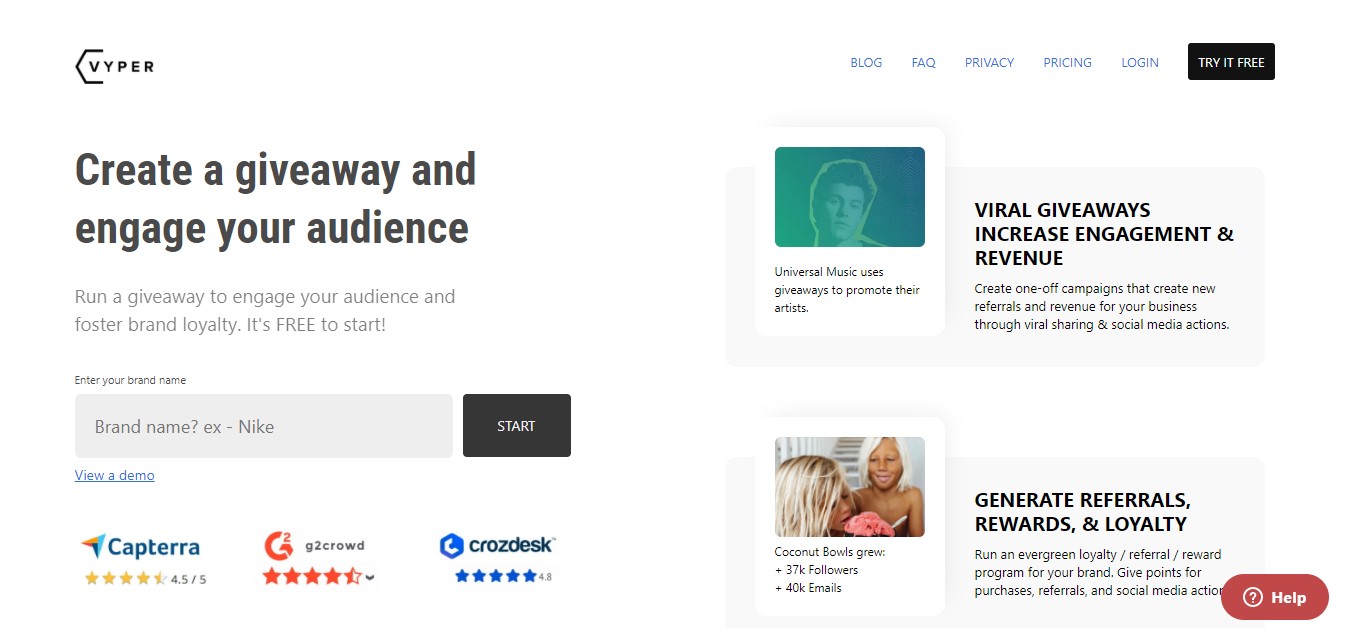
Conclusion
B2B lead generation is an often complicated process, but it doesn’t have to be. With the right tools and website lead generation strategies in place, you can significantly increase your lead generation efforts while simultaneously decreasing your workload.
Want to help contribute to future articles? Have data-backed and tactical advice to share? I’d love to hear from you!
We have over 60,000 monthly readers that would love to see it! Contact us and let's discuss your ideas!
